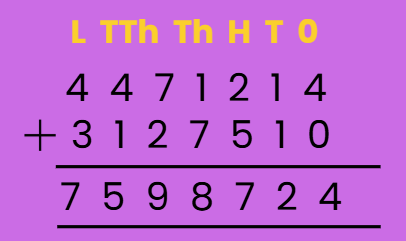Computation Operations | Math Olympiad for Class 5 PDF Download
Q1. What is the correct numeral for "Seventy-six crore twenty-three lakh forty-five thousand eight hundred nine"?
(a) 76,23,45,809
(b) 76,23,45,890
(c) 76,23,54,809
(d) 76,32,45,809
Ans: (a) 76,23,45,809
In the Indian numbering system, we separate numbers into periods (groups) using commas.
Now, let’s add them together:
Start with 76 crore → 76,00,00,000
Add 23 lakh → + 23,00,000
Now: 76,23,00,000
Add 45 thousand → + 45,000
Now: 76,23,45,000
Add 809 → + 809
Final number: 76,23,45,809
Q2. Which of the following is the expanded form of 45,76,90,213?
(a) 40,00,00,000 + 5,00,00,000 + 70,00,000 + 6,00,000 + 90,000 + 200 + 10 + 3
(b) 4,00,00,00,000 + 50,00,00,000 + 7,00,00,000 + 60,00,000 + 9,00,000 + 0 + 200 + 10 + 3
(c) 40,00,00,000 + 5,00,00,000 + 7,00,00,000 + 6,00,000 + 9,000 + 200 + 10 + 3
(d) 4,00,00,00,000 + 5,00,00,000 + 7,00,000 + 6,00,000 + 90,000 + 0 + 200 + 10 + 3
Ans: (a)
The expanded form of a number breaks it into the sum of each digit multiplied by its place value.
Now, add all the terms
= 40,00,00,000 + 5,00,00,000 + 70,00,000 + 6,00,000 + 90,000 + 200 + 10 + 3
Q3. Which number is greater: 5,67,89,432 or 5,67,98,432?
(a) 5,67,89,432
(b) 5,67,98,432
(c) Both are equal
(d) Cannot be compared
Ans: (b) 5,67,98,432
5,67,98,432 > 5,67,89,432 because 98 thousand > 89 thousand.
Q4. What is the difference between the population of Greater Mumbai (1,63,68,084) and Chennai (64,24,624)?
(a) 99,43,460
(b) 1,00,00,000
(c) 98,43,460
(d) 99,53,460
Ans: (a) 99,43,460
Q5. Which is the smallest 6-digit number formed using digits 3, 0, 9, 5, 2, 7 without repetition?
(a) 023579
(b) 203579
(c) 302579
(d) 975320
Ans: (b) 203579
Place the smallest non-zero digit (2) first, followed by ascending order: 0, 3, 5, 7, 9.
Q6. Add 44,71,214 and 31,27,510. What is the sum?
(a) 75,98,724
(b) 76,98,724
(c) 75,98,824
(d) 76,08,724
Ans: (a) 75,98,724
Q7. How is 10 lakh written in the International System?
(a) 1 million
(b) 10 million
(c) 100 million
(d) 1 billion
Ans: (a) 1 million
10 lakh = 1,000,000 = 1 million.
Q8. Arrange in descending order: 3,45,67,890; 9,87,65,432; 1,23,45,678; 5,55,55,555.
(a) 9,87,65,432 > 5,55,55,555 > 3,45,67,890 > 1,23,45,678
(b) 9,87,65,432 > 3,45,67,890 > 5,55,55,555 > 1,23,45,678
(c) 1,23,45,678 > 3,45,67,890 > 5,55,55,555 > 9,87,65,432
(d) 5,55,55,555 > 9,87,65,432 > 3,45,67,890 > 1,23,45,678
Ans: (a)
Compare digits from left: 9 > 5 > 3 > 1.
Q9. What is the numeral for "Six hundred ninety million four hundred forty-one thousand six hundred twenty-seven"?
(a) 69,04,41,627
(b) 690,441,627
(c) 6,90,44,16,27
(d) 69,44,16,27
Ans: (b) 690,441,627
International System uses commas after every 3 digits.
Q10. Subtract 65,24,89,07 from 86,16,52,81. What is the result?
(a) 20,91,63,74
(b) 20,91,63,83
(c) 20,61,93,74
(d) 20,91,63,47
Ans: (a) 20,91,63,74
86,16,52,81 – 65,24,89,07 = 20,91,63,74.
|
37 videos|109 docs|51 tests
|
FAQs on Computation Operations - Math Olympiad for Class 5
| 1. What are computation operations in mathematics? |  |
| 2. How do I teach my child basic computation operations? |  |
| 3. What is the importance of learning computation operations in Class 5? |  |
| 4. Can computation operations be applied in real life? |  |
| 5. How can I improve my child's speed and accuracy in computation operations? |  |






















